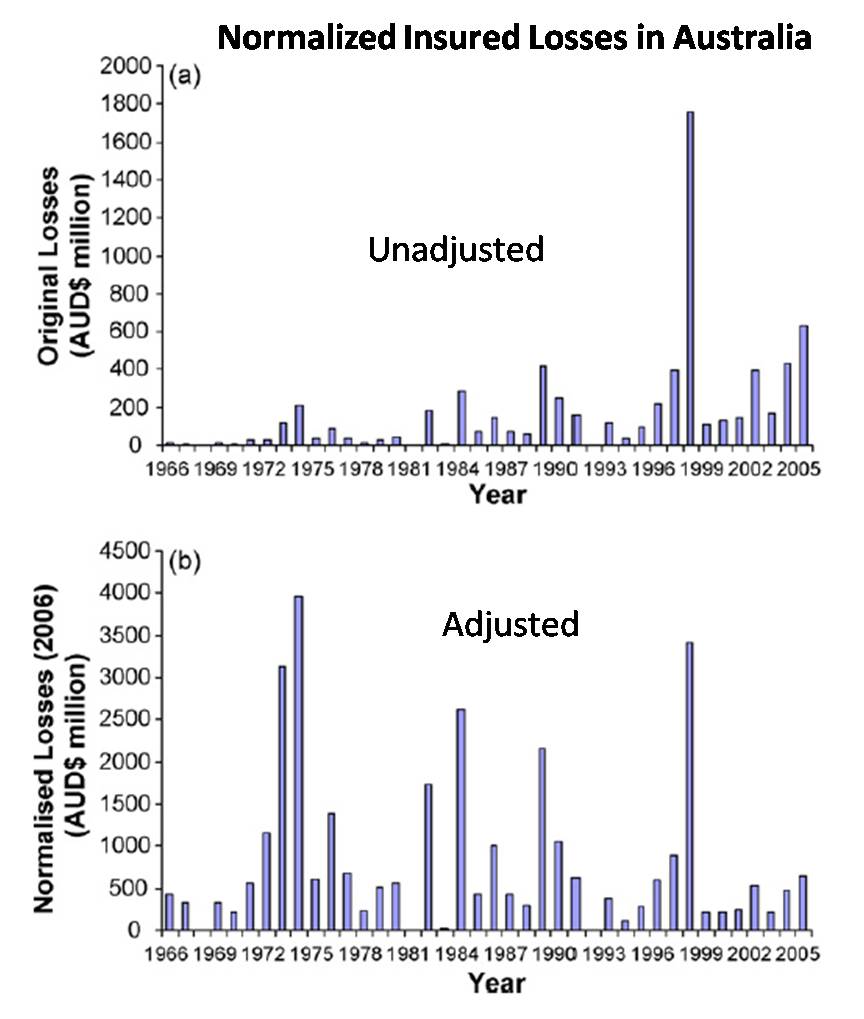Normalised Australian insured losses from meteorological hazards: 1967–2006
June 27th, 2008Posted by: Roger Pielke, Jr.

Ryan Crompton and John McAneney of Macquarie University in Sydney, Australia have an important new paper in the August, 2008 issue of the journal Environmental Science & Policy titled “Normalised Australian insured losses from meteorological hazards: 1967–2006.” (Available to subscribers here). The paper contributes to a growing literature that documents the importance of understanding the integrated effects of societal change and climate change. The paper also underscores the central role that adaptation policies must play in climate policy.
The abstract states:
Since 1967, the Insurance Council of Australia has maintained a database of significant insured losses. Apart from five geological events, all others (156) are the result of meteorological hazards—tropical cyclones, floods, thunderstorms, hailstorms and bushfires. In this study, we normalise the weather-related losses to estimate the insured loss that would be sustained if these events were to recur under year 2006 societal conditions. Conceptually equivalent to the population, inflation and wealth adjustments used in previous studies, we use two surrogate factors to normalise losses—changes in both the number and average nominal value of dwellings over time, where nominal dwelling values exclude land value. An additional factor is included for tropical cyclone losses: this factor adjusts for the
influence of enhanced building standards in tropical cyclone-prone areas that have markedly reduced the vulnerability of construction since the early 1980s.Once the weather-related insured losses are normalised, they exhibit no obvious trend over time that might be attributed to other factors, including human-induced climate change. Given this result, we echo previous studies in suggesting that practical steps taken to reduce the vulnerability of communities to today’s weather would alleviate the impact under any future climate; the success of improved building standards in reducing tropical cyclone wind-induced losses is evidence that important gains can be made through disaster risk reduction.
The text of the paper includes this discussion:
The collective evidence reviewed above suggests that societal factors – dwelling numbers and values – are the predominant
reasons for increasing insured losses due to natural hazards in
Australia. The impact of human-induced climate change on insured losses is not detectable at this time. This being the case, it seems logical that in addition to efforts undertaken to reduce global greenhouse gas emissions, significant investments be made to reduce society’s vulnerability to current and future climate and the associated variability. Employing both mitigation and adaptation contemporaneously will benefit society now and into the future.We are aware of few disaster risk reduction policies explicitly developed to help Australian communities adapt to a changing climate, yet disaster risk reduction should be core to climate adaptation policies (Bouwer et al., 2007). . .
An increased threat from bushfires under human-induced climate change is often assumed. Indeed Pitman et al. (2006) and others anticipate an increase in conditions favouring bushfires. However, analyses by McAneney (2005) and Crompton et al. (in press) suggest that the main bushfire menace to building losses will continue to be extreme fires and that the threat to the most at-risk homes on the bushland– urban interface can only be diminished by improved planning regulations that restrict where and how people build with respect to distance from the forest. Disaster risk reduction of this kind would immediately reduce current and future society’s vulnerability to natural hazards.
Please read the whole paper.